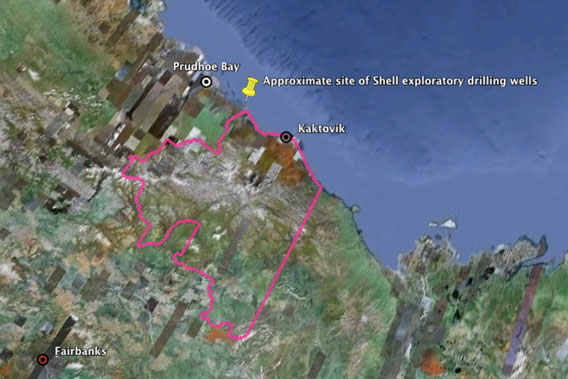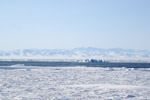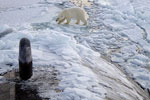
Approximate site of preliminarily approved drilling by Shell in the Chukchi Sea. Pink outline is the Arctic National Wildlife Refuge (ANWR). Image made with Google Earth.
The clock is running out for oil giant, Royal Dutch Shell, to drill controversial oil wells in the U.S. Arctic before the harsh winter sets in, reports The Wall Street Journal and Bloomberg. While the company is still optimistic it can reach the Arctic by summer’s end, it awaits a number of final permits after suffering numerous setbacks, including one of its drilling ships going adrift and nearly running aground in Alaska.
If it makes it to its drilling sites, the company would have to complete any operations by September 24th in the Chukchi Sea and October 31st in the Beaufort Sea, giving the company only a few weeks of operable time. Initially, the company planned to drill five oil wells this summer, but it is now planning only two.
Shell’s Arctic plans have been heavily criticized by a broad swathe of environmental and indigenous rights groups, who say the company has no adequate plan to deal with an oil spill in the Arctic’s mercurial waters, far from any infrastructure. Shell says that if a spill occurs it is capable of encountering 95 percent of the oil, however it doesn’t say how it would remove the oil it encounters.
As Arctic sea ice melts due to climate change, many nations, from the U.S. to Russia, are viewing the region as a new treasure chest of fossil fuel energy, which, if tapped, will worsen climate change worldwide.
Related articles
(08/16/2012) Four weeks before Greenland’s melting season usually ends, it has already blown past all previous records. By August 8th, nearly a month before cooler weather usually sets in around the world’s largest island, the island toppled the past record set in 2010.
Greenpeace activists occupy icebreaker set for Arctic drilling
(05/01/2012) Greenpeace has announced that 20 of its activists, stemming from 13 countries, have locked themselves in an icebreaker ship in Helsinki, Finland. The ship is scheduled to move out to the Alaskan Arctic to aid in exploratory offshore drilling by oil giant Shell. Another icebreaker has already left for the U.S. Arctic; both have been leased to Shell by their owner, the Finnish government.
Obama Administration, Shell moving ahead with Arctic oil exploitation

(04/02/2012) Last week, the U.S. Department of the Interior approved oil spill clean-up plans by Royal Dutch Shell Oil in the Beaufort Sea, paving the way for offshore oil drilling in the Arctic to begin as soon this year. The Interior’s approval was blasted by environmentalists, who contend that oil companies have no viable way of dealing with a spill in the icy, hazardous conditions of the Arctic, far from large-scale infrastructure. Shell, which has spent $4 billion to date to gain access to the Arctic, must still be granted final permits for drilling.
Arctic warms to highest level yet as researchers fear tipping points

(02/13/2012) Last year the Arctic, which is warming faster than anywhere else on Earth due to global climate change, experienced its warmest twelve months yet. According to recent data by NASA, average Arctic temperatures in 2011 were 2.28 degrees Celsius (4.1 degrees Fahrenheit) above those recorded from 1951-1980. As the Arctic warms, imperiling its biodiversity and indigenous people, researchers are increasingly concerned that the region will hit climatic tipping points that could severely impact the rest of the world. A recent commentary in Nature Climate Change highlighted a number of tipping points that keep scientists awake at night.
Opposition rising against U.S. Arctic drilling
(02/09/2012) Drilling in the Arctic waters of the U.S. may become as contested an issue as the Keystone Pipeline XL in up-coming months. Scientists, congress members, and ordinary Americans have all come out in large numbers against the Obama Administration’s leases for exploratory drilling in the Beaufort Sea and the Chuckchi Sea.







